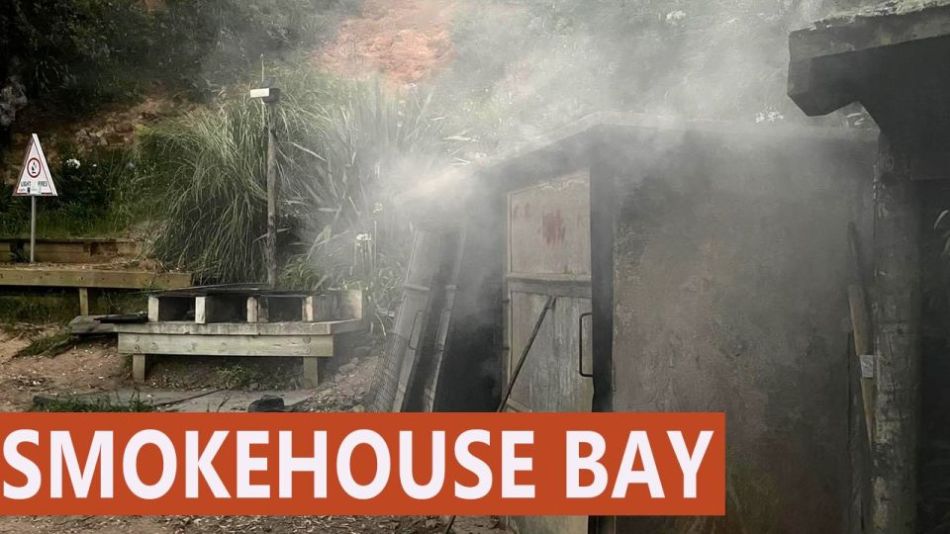
Smokehouse Bay, Great Barrier Island: A sailor's paradise
April 12th, 2024
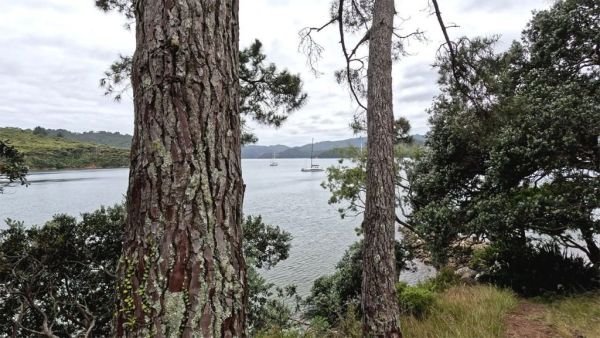
A view of the anchorage from the walking track above Smokehouse Bay. This is where we saw a stingray swimming in the shallow water.
Smokehouse Bay is an anchorage situated in Port Fitzroy, Aotea (Great Barrier Island) and is a popular anchorage for boaties. Alongside its natural beauty, once ashore it doesn't take long to see the onshore facilities in the bay to know why this is a cruiser's paradise. This anchorage has everything that a sailor could dream of, which makes it very tempting to stay as long as the weather and food supplies allow. The onshore land and facilities were provided by the Webster family with volunteers helping maintain them. There's a donation box which helps them raise money to maintain these facilities. A worthy cause. Smokehouse Bay is only accessible by boat.
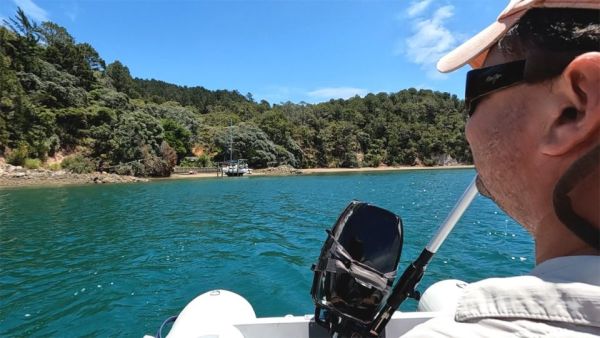
A view of Smokehouse Bay from the dinghy
The onshore facilities start with the tender (or dinghy) ride to shore. As soon as you approach shore, a few things immediately become visible. A few meters from the shore is a tidal grid, which allows boaties (size and draw dependent) to tie up alongside and dry out their boats to do some maintenance work. It is unclear what type of work is allowed to be undertaken here but while here, we did see a yacht dry out to check their anodes. Tying up the tender is also very easy here with purpose-built facilities to do so. Word of warning though, there is quite a tidal difference here (about 2 m difference), which is good to know if you have a big heavy dinghy.
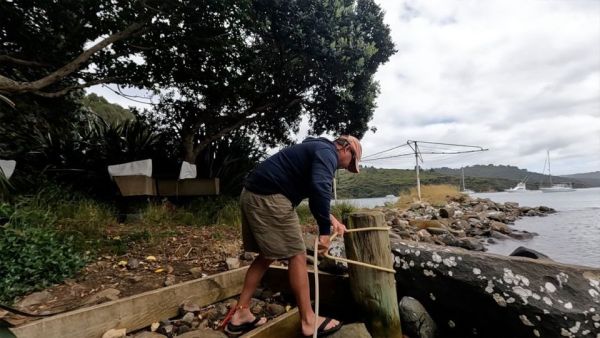
Securing the dinghy
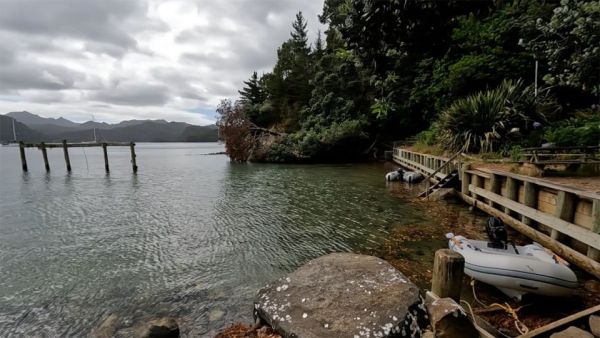
A view of the tidal frame and dinghy dock from the onshore clothes washing
The onshore facilities include three concrete washing tubs with water supply, where laundry can be done. Next to these tubs are a series of hand wringers where clothes can be wringed after washing. But wait, there's more! A few meters from these hand wringers are rotary clothes lines where you can hang clothes to dry. Pegs are not included so you do have to bring your own pegs. Our sailboat holds 400 liters of water and we have no water maker so washing clothes in remote locations can use up a lot of our water supply. We took full advantage of this facility and it did not disappoint.
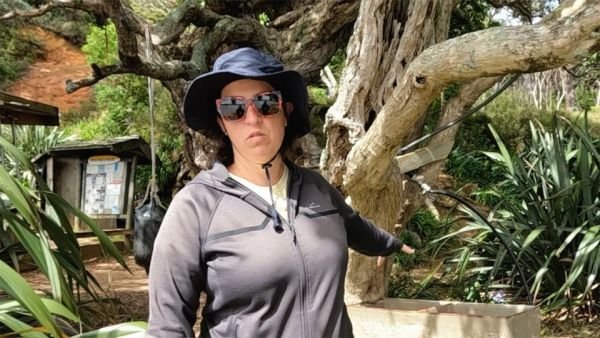
The concrete washing basins available onshore
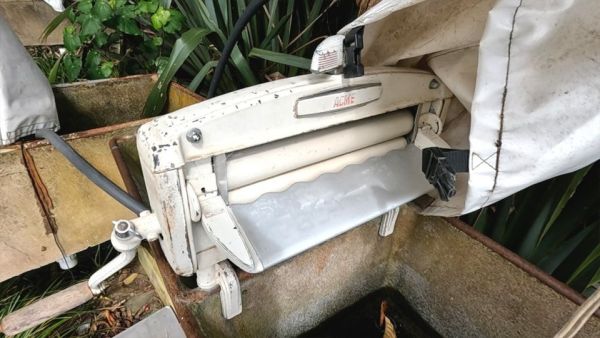
The manual clothes wringer
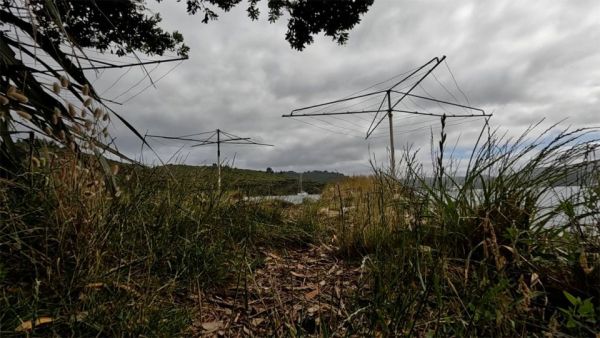
Rotary washing lines
Next to the clothes washing facilities is what we called the social area. In this area, it has everything you can think of to create an atmosphere where boaties can easily get together and socialise. What's the best way to do this? Over food of course! In this area, there is a pizza oven, a fire pit with seats around it so people can sit around the fire and spin yarns. There's also a smokehouse where fish can be smoked and a barbeque area.
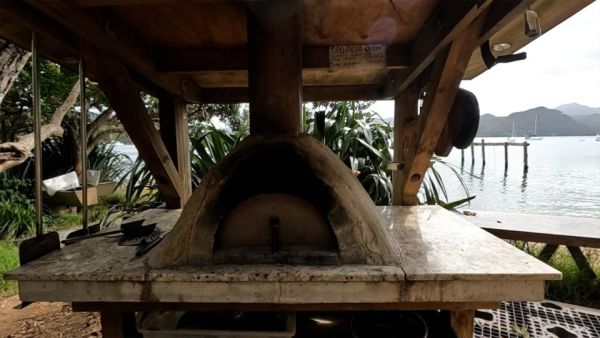
Pizza oven waiting to be used
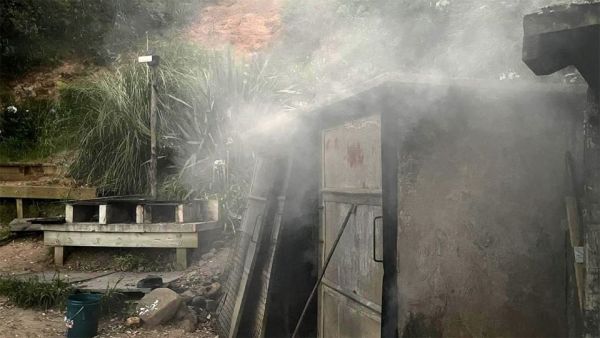
Smokehouse in action
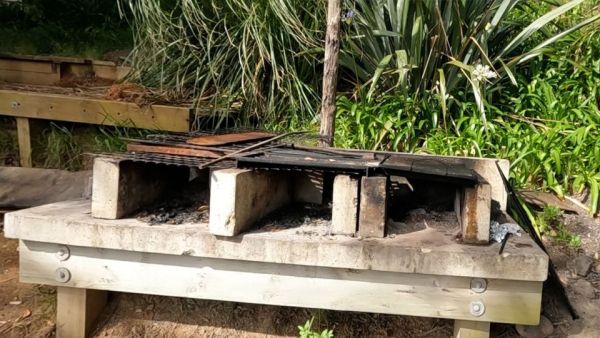
Barbeque facilities
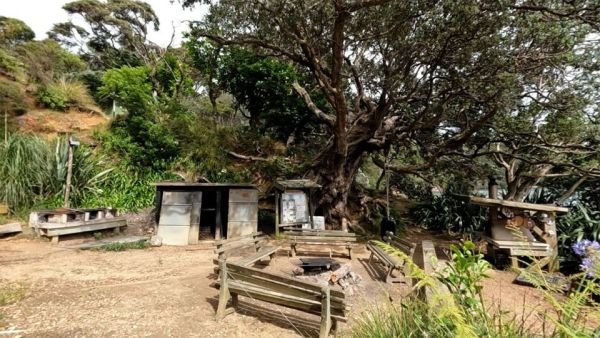
A view of the fire pit from the bath house where people can sit and socialise around the fire
A swing made from a really big fender hangs in a pōhutukawa tree right by the camp fire provides a place for one to swing the afternoon away. Right now you're probably thinking, nice one and wondering how can this place get any better? Well, it does. Next to this social area is the bathing area. There's an outside bath with a shower that allows for some alfresco bathing. Next to this, is the bathhouse which provides a more private bathing area. In here is a bathtub with a shower. Outside the wash house is a wood stove that heats up the water for the shower. They've thought of everything. Up from the shore facilities is a toilet. We didn't visit the toilet so we are unsure if it's composting.
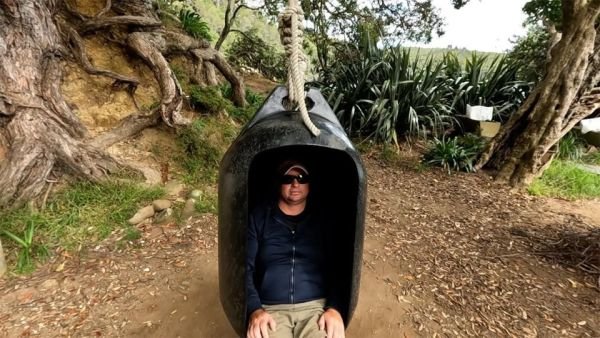
Adam enjoying a swing in the fender-made swing
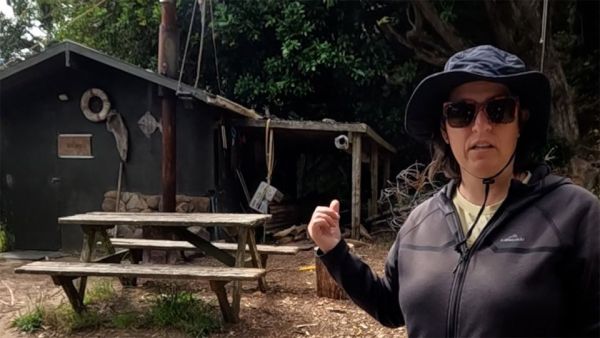
Vicki pointing to the bath house
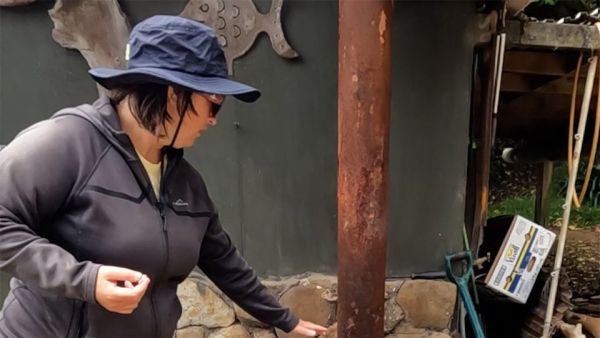
Vicki feeling the heat coming from the woodfire
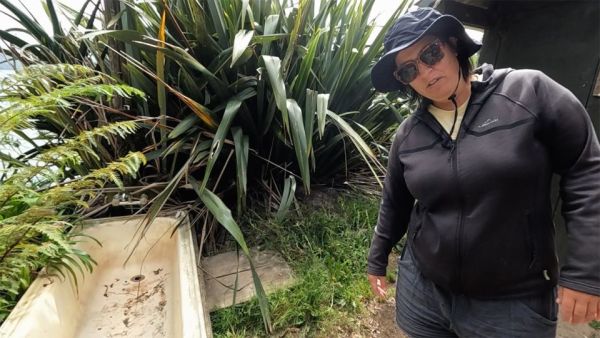
The outside bath with a shower where one can enjoy an alfresco dip
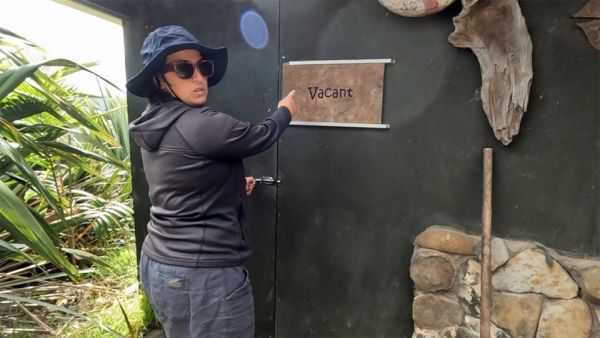
Vicki pointing to the in use sign of the bath house
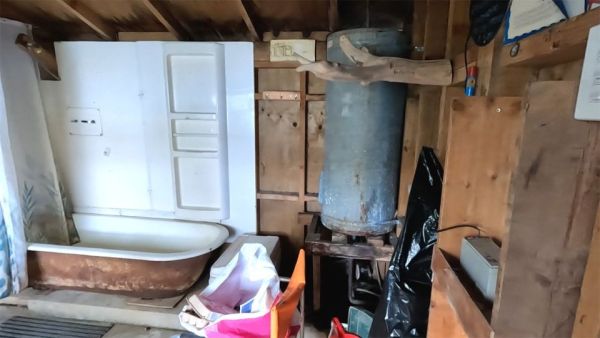
The bath/shower of the bath house
Now you can see why this is such a popular spot for boaties. We anchored at Smokehouse Bay two weeks before Christmas and even then it was a busy spot with many boaties taking advantage of the settled weather to get out to Great Barrier Island. When all the onshore facilities are in use, which is often, it doesn't take long to see how Smokehouse Bay got it's name. This anchorage just has such a positive vibe and because of the onshore facilities, it doesn't take long to meet new people and make friends.
There's one more dimension to Smokehouse Bay and that is the walk that you can do from it. There's a track that starts by the concrete washing tubs and takes you up the hill. As you climb up the hill, it's hard not to stop and take in the beautiful views of Smokehouse Bay. We saw a stingray from up here gently gliding through the shallows. This walk takes you through a fern and kānuka forest to a dirt road. From here it's a gentle climb where we made our way up to some bee hives before making our way back to the anchorage. This walk not only provides an opportunity to get some exercise but also provides stunning views of the Hauraki Gulf and Port Fitzroy.
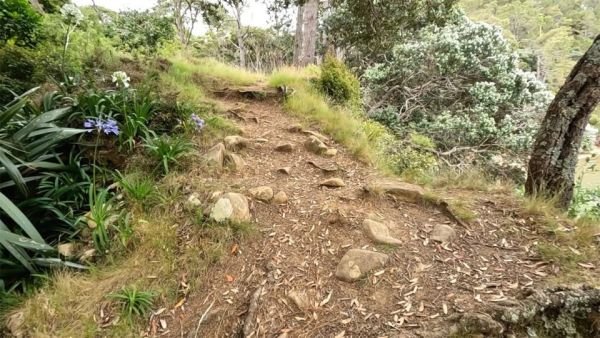
The start of the walking track from Smokehouse Bay
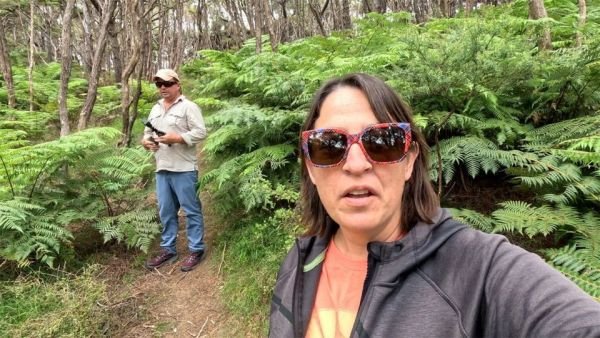
Standing in the fern/kānuka forest at the top of Smokehouse Bay
We thoroughly enjoyed our time at Smokehouse Bay. If you wanted a visual tour of Smokehouse Bay and the walk from it, watch the video below.
A bit more about Great Barrier Island
Great Barrier Island was named so as it is said to provide a barrier, protection, to mainland New Zealand. Aotea is one of the many islands in the Hauraki Gulf and sits approximately 50 nautical miles north east from central Auckland and 13 nautical miles from the top of the Coromandel Peninsula. It is 285 km2 and 45 km long. A very settled weather window is needed to sail to Great Barrier Island from mainland New Zealand. We've heard stories where people have had great sails but also terrible sails to/from Great Barrier Island. We had a good sail to and from it but the wind did pick up around it for us. Sailing to the Barrier (as locals call it) is often considered to be a milestone for some sailors. We sailed overnight from Deep Water Cove in the Bay of Islands to Port Fitzroy in Great Barrier Island, a journey of 83 nautical miles which took us just over 15 hours. We would have loved to have seen more of the other anchorages that the Barrier offers but we were limited by time and anchoring restrictions were in place to minimise the spread of the invasive caulerpa seaweed. Very settled weather is also needed to sail around the Barrier as it sits in the outer Hauraki Gulf and is very exposed to weather conditions. To live on the Barrier, you have to be self-sufficient as there are no water or power services. Many locals have solar power. If you don't have a boat to sail to the Barrier, you can get there by ferry and by air. Ferries go to Port Fitzroy and Tryphena harbours and takes approximately 4.5 hours from Auckland.